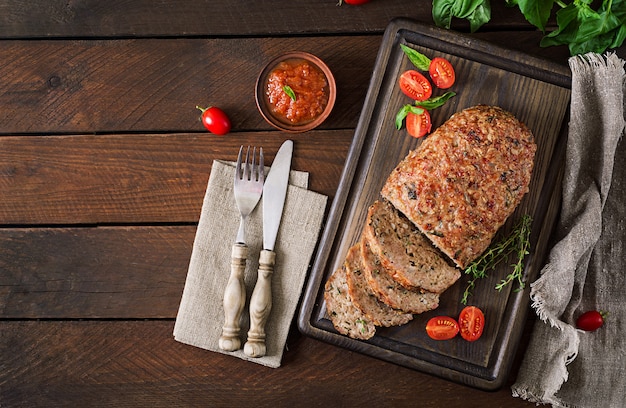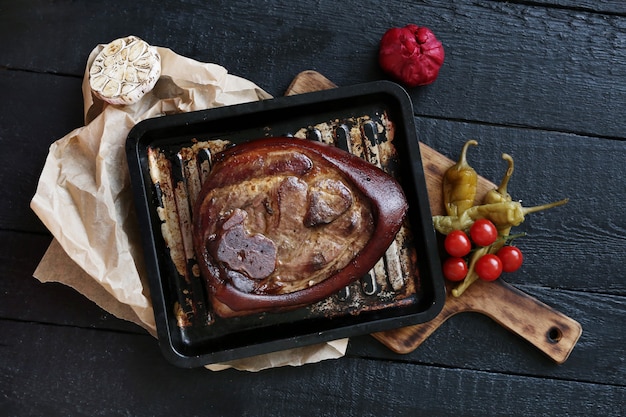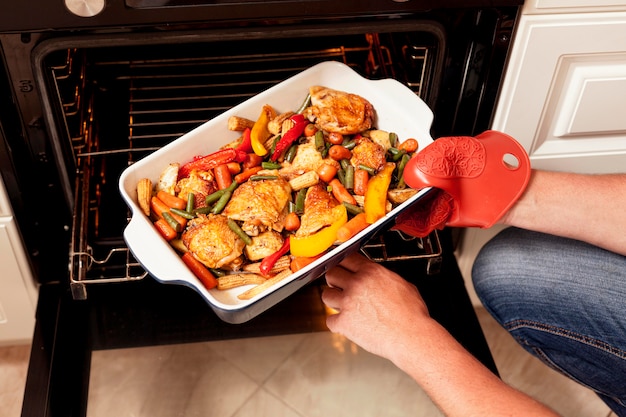Ah, filet mignon. The mere mention of this glorious cut of beef evokes images of luxurious dinners, special occasions, and those “wow” moments that make a meal truly memorable. I've been a passionate cook for years, and there’s nothing quite like nailing a perfectly cooked filet mignon. It’s a dish that screams elegance, but let me tell you, it’s totally achievable, even for a home cook like me.
This guide is your key to unlocking the secrets of the perfect oven-cooked filet mignon. We’ll cover everything from selecting the right cut and prepping it with expert tips to mastering the art of oven cooking, achieving that coveted sear and juicy interior. We’ll even delve into the world of delectable sauces and sides to complete your culinary masterpiece. So, grab your favourite glass, settle in, and let’s get cooking!
(Part 1) Choosing the Right Filet Mignon: Your Foundation for Success

The first step in this culinary adventure is choosing the right filet mignon. You’re aiming for a cut that’s tender, juicy, and packed with flavour. Trust me, it’s all about setting yourself up for success! So, let’s dive into the world of beef and figure out what makes a filet mignon truly special.
1. The Marbling Factor: A Key to Juiciness and Flavour
Think of marbling like the intricate veins of a magnificent marble sculpture. It’s the network of fat streaks that run through the meat, and it’s crucial for achieving that mouthwatering tenderness and flavour. The fat melts as it cooks, bathing the meat in its delicious richness, giving you a succulent and flavourful bite. You want to look for a filet with a good, even distribution of marbling, like a beautiful, harmonious pattern throughout the meat.
2. Thick and Tender: Why Size Matters
When choosing a filet, don’t be shy about going for a thick cut. It’s like giving yourself a little wiggle room for perfection. A thicker cut ensures the filet cooks evenly and resists drying out. Aim for a filet that’s at least 1.5 inches thick, or better yet, 2 inches. This gives you the best chance of achieving that luscious, juicy interior with a perfectly crisp exterior.
3. Prime Cuts and Choice Cuts: Understanding Beef Grades
Now, let's talk about those grades you see on the meat labels. The grade indicates the quality of the beef, and trust me, it makes a difference. Prime grade is the highest grade, renowned for its rich flavour and buttery tenderness. If you’re going all out for a special occasion, Prime grade is the way to go. But don't fret if Prime grade isn't within your budget. Choice grade is still a great choice! It's one level below Prime, and you can still expect a good quality cut with a delicious flavour.
(Part 2) The Art of Prepping: Preparing Your Filet for Oven Magic

Okay, you've got your filet mignon – a prime example of culinary excellence. Now, it’s time to get it ready for its star turn in the oven. Proper prepping is key to unlocking that juicy, flavorful steak you're dreaming of. Let’s get down to the details.
1. Pat Dry, Pat Perfect: The Secret to a Crisp Sear
Grab some paper towels and give your filet a good pat dry. This may seem like a simple step, but it's crucial for achieving that beautiful, crisp sear. Think of it like a little bit of preparation for a glamorous event - you wouldn't go out without a touch-up, would you?
2. Seasoning with Finesse: Enhancing the Natural Flavour
Now, the fun part – seasoning! I’m a firm believer in keeping things simple. I prefer a generous sprinkle of salt and freshly ground black pepper. It’s all about enhancing the natural, rich flavour of the beef. You can also add a touch of garlic powder, onion powder, or paprika, but I find salt and pepper are enough to elevate the steak. Don't be shy with the salt; it’s not about making it salty, but bringing out that exquisite, natural flavour.
3. Rest and Relax: Letting the Filet Settle in
Before you send your filet to the oven, let it rest at room temperature for about 30 minutes. This gives the meat a chance to come to room temperature, which helps it cook more evenly. Imagine it’s like letting your steak have a relaxing chat with the kitchen air – a little prep before the big event.
(Part 3) Oven-Cooking Your Filet Mignon: Achieving Precision and Perfection

We’re almost there! Your filet is prepped and ready to shine. Now, it’s time to unleash the power of your oven. With a little know-how, you can create a beautifully seared and juicy masterpiece. Let’s dive into the process.
1. The Power of Preheat: Setting the Stage for Success
First things first, preheat your oven to 400°F (200°C). It's like warming up the stage for your culinary star. A hot oven ensures quick and even cooking, helping you achieve that gorgeous sear and maintain a tender, juicy interior.
2. Searing for Success: Creating a Delicious Crust
Now, it’s time to give your filet a good sear. This crucial step locks in those precious juices and gives your steak that irresistible, crispy crust. You can use a cast iron skillet for a beautiful sear, but a regular oven-safe skillet works just fine. Heat your chosen skillet over medium-high heat, add a little oil (grapeseed oil works great because it has a high smoke point), and let it shimmer. Carefully place your filet in the hot skillet and sear for 2-3 minutes per side. This is how you get that amazing, crusty exterior, a little bit of gourmet magic!
3. Finishing in the Oven: The Final Touch for Perfection
Now, it’s time to move your filet to the oven for the finishing touches. Transfer it to a baking sheet or a roasting pan and pop it into your preheated oven. The exact cooking time depends on the thickness of your filet and your preferred level of doneness. Here’s a general guide to help you nail it:
| Doneness | internal temperature (°F) | Cooking Time |
|---|---|---|
| Rare | 125-130°F | 5-7 minutes |
| Medium Rare | 130-135°F | 7-9 minutes |
| Medium | 135-140°F | 9-11 minutes |
| Medium Well | 140-145°F | 11-13 minutes |
| Well Done | 145-150°F | 13-15 minutes |
Remember, these are just guidelines. To ensure absolute perfection, use a meat thermometer to check the internal temperature of your filet. Insert it into the thickest part of the steak, making sure it’s not touching any bone. Once it hits your desired internal temperature, it’s ready to come out of the oven!
(Part 4) Resting: Giving Your Filet a Moment to Relax and Rejuvenate
This crucial step is often overlooked, but trust me, it's like giving your filet a spa day! Let it rest for 10-15 minutes before slicing and serving. This allows the juices to redistribute throughout the steak, resulting in a more tender and juicy piece of meat. The resting process is about letting the steak relax and retain all its flavour – the perfect way to end its journey in the oven.
(Part 5) The Sauce Factor: Elevating Your Filet Mignon to New Heights
Your filet mignon is cooked to perfection, rested, and ready to shine. Now, let’s talk about the sauce that will truly make this dish sing. A good sauce can elevate any steak, adding a depth of flavour and a touch of culinary artistry. Let’s explore some options.
1. The Classic Red Wine Reduction: Simplicity at its Best
A simple and classic sauce that never fails to impress is a red wine reduction. Here’s how to create this culinary magic:
a. Deglazing the Pan: Capturing Flavourful Essence
Once your filet is out of the oven, pour off any excess fat from the pan. Add a tablespoon of butter to the pan and swirl it around until melted. Now, pour in half a cup of red wine and let it simmer until it reduces by half. This is called deglazing, and it’s a fantastic way to capture all those delicious, caramelized bits from the bottom of the pan, infusing your sauce with a symphony of flavour.
b. Adding Depth of Flavour: A Symphony of Taste
Now, add a tablespoon of beef broth, a teaspoon of Dijon mustard, and a pinch of salt and pepper. Simmer the sauce for a few more minutes until it slightly thickens. For an extra touch of magic, you can add a tablespoon of chopped fresh herbs, like thyme or rosemary. It’s the perfect way to add a touch of aromatic elegance to your sauce.
c. The Final Touch: Adding a Touch of Glossy Glamour
To complete this culinary masterpiece, whisk in a tablespoon of cold butter. It’s a simple step, but it transforms the sauce, giving it a beautiful, glossy finish. It’s the little details that make a big difference!
(Part 6) Serving Your Culinary Triumph: A Symphony of Flavours
Alright, the moment you’ve been waiting for – your perfectly cooked, rested filet mignon is ready to take centre stage. Let’s talk about the final touches that will create a truly unforgettable meal. It’s about those little details, those finishing touches, that elevate your culinary creation to a work of art.
1. Slicing with Precision: Revealing the Beauty Within
Slice your filet mignon against the grain into 1/2-inch thick slices. This ensures each slice is tender and easy to chew, revealing the beautiful, even cook and the juicy interior you’ve worked so hard for. It’s a visual delight as well as a flavourful one.
2. Choosing Sides: A Culinary Harmony of Flavours
Now, it’s time to select your side dishes! Filet mignon is incredibly versatile, pairing beautifully with a wide range of accompaniments. Let your culinary imagination run wild. Here are a few of my personal favourites, each bringing a unique element to the table:
- mashed potatoes: Classic, comforting, and always a crowd-pleaser. It’s a timeless side that complements the richness of the filet mignon perfectly.
- roasted asparagus: A healthy and delicious option that adds a fresh, vibrant element to the plate.
- Creamed spinach: A rich and creamy side that complements the steak beautifully. It adds a touch of indulgence and a burst of green to the plate.
- grilled portobello mushrooms: A meaty and flavourful vegetarian option that provides a satisfying textural contrast.
The key is to choose sides that complement the flavour of the steak without overpowering it. You want your filet mignon to be the star, but a good side dish can add that extra touch of harmony and elevate the overall experience. And hey, if you're feeling adventurous, feel free to add a few more sides. A small salad, for example, adds a touch of freshness and a splash of colour to your culinary masterpiece.
(Part 7) Mastering the Art of Filet Mignon: A Journey of Culinary Exploration
Now, I'm not going to sugarcoat it – cooking the perfect filet mignon takes practice. It's about understanding the nuances of heat, time, and the interaction between the meat and the oven. But don't be discouraged! It’s a journey of culinary exploration, and each attempt is a chance to learn and refine your skills. I remember the first time I tried to cook filet mignon. I was a nervous wreck! I wasn’t sure about the sear, and I was terrified of overcooking it. But I persisted, and with each attempt, I gained confidence and learned something new. And you know what? The more I cooked, the better I got at it.
Here are a few tips to help you along your path to filet mignon mastery:
- Embrace experimentation. Don't be afraid to try different seasonings, sauces, and sides. Find what your palate loves and let your creativity flow!
- Invest in a good meat thermometer. It's a little investment that can ensure your filet is cooked to your exact preference. It's the best way to avoid any surprises and guarantee a perfectly cooked steak every time.
- Take your time and enjoy the process. cooking filet mignon is an art, and it's about savouring each step, from selecting the cut to the final resting period.
Cooking filet mignon is a skill that takes time and practice, but it's a rewarding journey that leads to culinary mastery. And hey, if you find yourself in need of a little guidance, don't hesitate to ask for help. The world of cooking is full of supportive resources – online forums, cooking classes, and fellow passionate cooks are always ready to share their knowledge and tips.
(Part 8) Filet Mignon: More Than Just a Dish, It's a Culinary Statement
Let's be real, filet mignon is more than just a dish. It’s a symbol of indulgence, a touch of luxury, and a celebration of life's special moments. Whether you’re celebrating a milestone, impressing a date, or simply treating yourself to a delicious meal, a perfectly cooked filet mignon elevates the ordinary to the extraordinary.
There's a certain magic to that perfectly seared exterior, that tender, juicy interior, and that melt-in-your-mouth texture. It's a dish that brings people together, sparks conversation, and creates those delicious memories that we cherish. So, go ahead, indulge yourself. Treat yourself to a filet mignon. You deserve it. After all, you've worked hard to master the art of cooking this culinary masterpiece – you've earned it!
FAQs
1. What if I Don’t Have a Meat Thermometer?
Even without a meat thermometer, you can still cook a fantastic filet mignon. It just takes a little extra practice and observation. You can estimate the doneness based on the steak’s appearance. A rare steak will have a cool, red centre. A medium-rare steak will have a warm, red centre, while a medium steak will have a pink centre. A medium-well steak will have a slightly brown centre, and a well-done steak will have a completely brown centre. But hey, if you're serious about your steak game, consider ordering a meat thermometer online – it's a small investment that will pay off in consistently delicious meals!
2. Can I Cook Filet Mignon on the Grill?
Absolutely! grilling filet mignon is a fantastic way to add a delicious smoky flavour to your meal. Pre-heat your grill to medium-high heat and sear the filet for 2-3 minutes per side. Then, move it to a cooler part of the grill and cook for another 5-7 minutes, or until it reaches your desired level of doneness. You can also try using a cast iron pan on the grill for a more even sear.
3. What are Some Other Delicious Sauce Options for Filet Mignon?
You can never have too many sauce options! Here are a few more ideas to explore:
- Béarnaise sauce: A classic French sauce that's rich, creamy, and tangy, adding a touch of sophistication to your meal.
- Peppercorn sauce: A bold and spicy sauce made with cracked peppercorns, butter, and cream, perfect for those who like a bit of heat.
- Mushroom sauce: A hearty and flavourful sauce made with sautéed mushrooms, onions, and cream, adding an earthy, savoury dimension to the steak.
- Garlic butter sauce: A simple and delicious sauce made with melted butter, garlic, and parsley, a classic that never disappoints.
4. Can I Cook a Filet Mignon from Frozen?
I wouldn’t recommend it. Freezing and thawing meat can affect its texture and flavour. It’s best to thaw your filet mignon in the refrigerator overnight before cooking.
5. How do I Store Leftover Filet Mignon?
If you have any leftover filet mignon, store it in an airtight container in the refrigerator for up to 3 days. You can reheat it in the oven or in a microwave, but be careful not to overcook it. Leftover filet mignon makes fantastic sandwiches or salads, adding a touch of elegance to a quick meal.
And there you have it, a comprehensive guide to cooking the perfect filet mignon in the oven. Now, go forth, embrace your inner chef, and create culinary masterpieces that will impress everyone around you! Happy cooking!
Everyone is watching

Prime Rib Roast Cooking Time Chart: Per Pound Guide
Cooking TipsPrime rib roast. Just the name conjures images of lavish dinners, crackling fires, and hearty laughter. It’s ...

How Long to Bake Potatoes in the Oven (Perfect Every Time)
Cooking TipsBaked potatoes are a staple in my kitchen. They're incredibly versatile, delicious, and surprisingly easy to m...

Perfect Rice Every Time: The Ultimate Guide to Cooking Rice
Cooking TipsAs a self-proclaimed foodie, I've always been a bit obsessed with rice. It's the foundation of countless cuisi...

The Ultimate Guide to Cooking Asparagus: Tips, Techniques, and Recipes
Cooking TipsAsparagus. The mere mention of this spring delicacy conjures up images of vibrant green spears, crisp and burs...

Ultimate Guide to Cooking the Perfect Thanksgiving Turkey
Cooking TipsThanksgiving. Just the word conjures up images of overflowing tables laden with delicious food, the scent of r...
